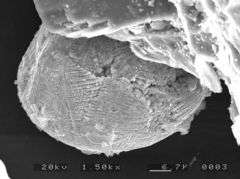Microscopic meteorites show early life on Earth faced rain of rocks

(PhysOrg.com) -- Microscopic meteorites found in Scotland have unveiled major clues about a catastrophic event which dramatically altered the Earth’s surface nearly 500 million years ago.
The evidence shows that life at this time, which was restricted to the seas, faced the consequences of an event far out in space.
Recent studies in Sweden have revealed that a massive collision in the asteroid belt between Mars and Jupiter resulted in thousands of meteorites landing on the Earth.
Studies by experts from the University of Aberdeen have now uncovered tiny remnants of meteorites, smaller than a grain of sand, within rocks exposed along the shore near Durness, which they believe can be tied to this event.
The find has confirmed previous scientific speculation, that this meteorite shower was so vast in size that it affected locations across the globe including Scotland.
The study, led by Professor John Parnell from the School of Geosciences at the University of Aberdeen, has also shown that the meteorites falling to Earth may have been responsible for large earthquakes and tidal waves throughout the world.
The research, which has been published in Nature Geoscience this month, has revealed that in locations from China to the Yukon and Australia to Norway, large blocks of rock tumbled down slopes from shallow to deep water.
Pieces of rock the size of a football stadium also went sliding down hillsides in Korea, Argentina and the English Lake District.
These findings will now help scientists to investigate if there is any connection between the meteorites falling and the diversification of underwater species which took place around the same period.
Professor Parnell said: "We tested the piece of rock in Durness by dissolving the limestone in acid which allowed us to detect meteorites, smaller than can be seen by the naked eye. This confirmed that 470 million years ago these enormous meteorites fell in a wide span of locations across the globe – including Scotland. This is the first time we have been able to prove the mammoth scale of the event and just how many geographical locations felt its impact.
"Our research has also pinpointed that the meteorites falling caused earthquakes and tidal waves to take place at the edge of many continents. Records show that the underwater life which existed on Earth at this time became a lot more diverse directly after this major event. Any connection between these occurrences is not clear, but our findings will help us to investigate and potentially pinpoint how it happened."
Provided by University of Aberdeen




















